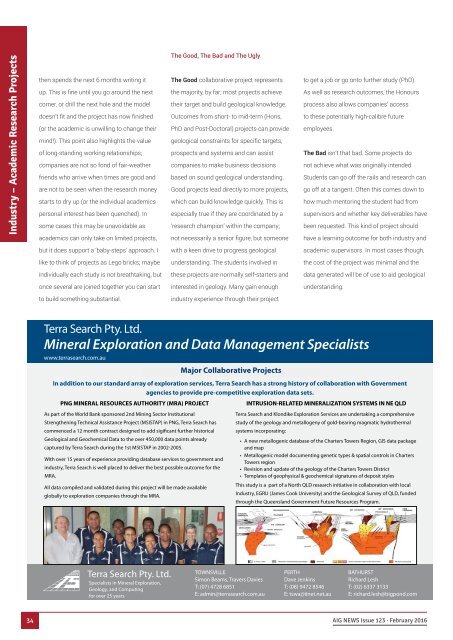Up & Coming Geoscientists - a sample of our AIG Honours Bursary Recipients
KMnJLq
KMnJLq
Create successful ePaper yourself
Turn your PDF publications into a flip-book with our unique Google optimized e-Paper software.
Industry – Academic Research Projects<br />
then spends the next 6 months writing it<br />
up. This is fine until you go around the next<br />
corner, or drill the next hole and the model<br />
doesn’t fit and the project has now finished<br />
(or the academic is unwilling to change their<br />
mind!). This point also highlights the value<br />
<strong>of</strong> long-standing working relationships;<br />
companies are not so fond <strong>of</strong> fair-weather<br />
friends who arrive when times are good and<br />
are not to be seen when the research money<br />
starts to dry up (or the individual academics<br />
personal interest has been quenched). In<br />
some cases this may be unavoidable as<br />
academics can only take on limited projects,<br />
The Good, The Bad and The Ugly<br />
The Good collaborative project represents<br />
the majority, by far; most projects achieve<br />
their target and build geological knowledge.<br />
Outcomes from short- to mid-term (Hons,<br />
PhD and Post-Doctoral) projects can provide<br />
geological constraints for specific targets,<br />
prospects and systems and can assist<br />
companies to make business decisions<br />
based on sound geological understanding.<br />
Good projects lead directly to more projects,<br />
which can build knowledge quickly. This is<br />
especially true if they are coordinated by a<br />
‘research champion’ within the company;<br />
not necessarily a senior figure, but someone<br />
to get a job or go onto further study (PhD).<br />
As well as research outcomes, the Hon<strong>our</strong>s<br />
process also allows companies’ access<br />
to these potentially high-calibre future<br />
employees.<br />
The Bad isn’t that bad. Some projects do<br />
not achieve what was originally intended.<br />
Students can go <strong>of</strong>f the rails and research can<br />
go <strong>of</strong>f at a tangent. Often this comes down to<br />
how much mentoring the student had from<br />
supervisors and whether key deliverables have<br />
been requested. This kind <strong>of</strong> project should<br />
have a learning outcome for both industry and<br />
but it does support a ‘baby-steps’ approach. I<br />
with a keen drive to progress geological<br />
academic supervisors. In most cases though,<br />
like to think <strong>of</strong> projects as Lego bricks; maybe<br />
understanding. The students involved in<br />
the cost <strong>of</strong> the project was minimal and the<br />
individually each study is not breathtaking, but<br />
these projects are normally self-starters and<br />
data generated will be <strong>of</strong> use to aid geological<br />
once several are joined together you can start<br />
interested in geology. Many gain enough<br />
understanding.<br />
to build something substantial.<br />
industry experience through their project<br />
Terra Search Pty. Ltd.<br />
Mineral Exploration and Data Management Specialists<br />
www.terrasearch.com.au<br />
Current Major Collaborative Projects<br />
in 2014<br />
In addition to <strong>our</strong> standard array <strong>of</strong> exploration services, Terra Search has a strong history <strong>of</strong> collaboration with Government<br />
agencies to provide pre-competitive exploration data sets.<br />
PNG MINERAL RESOURCES AUTHORITY (MRA) PROJECT<br />
As part <strong>of</strong> the World Bank sponsored 2nd Mining Sector Institutional<br />
Strengthening Technical Assistance Project (MSISTAP) in PNG, Terra Search has<br />
commenced a 12 month contract designed to add sigificant further historical<br />
Geological and Geochemical Data to the over 450,000 data points already<br />
captured by Terra Search during the 1st MSISTAP in 2002-2005.<br />
With over 15 years <strong>of</strong> experience providing database services to government and<br />
industry, Terra Search is well placed to deliver the best possible outcome for the<br />
MRA.<br />
All data compiled and validated during this project will be made available<br />
globally to exploration companies through the MRA.<br />
INTRUSION-RELATED MINERALIZATION SYSTEMS IN NE QLD<br />
Terra Search and Klondike Exploration Services are undertaking a comprehensive<br />
study <strong>of</strong> the geology and metallogeny <strong>of</strong> gold-bearing magmatic hydrothermal<br />
systems incorporating:<br />
• A new metallogenic database <strong>of</strong> the Charters Towers Region, GIS data package<br />
and map<br />
• Metallogenic model documenting genetic types & spatial controls in Charters<br />
Towers region<br />
• Revision and update <strong>of</strong> the geology <strong>of</strong> the Charters Towers District<br />
• Templates <strong>of</strong> geophysical & geochemical signatures <strong>of</strong> deposit styles<br />
This study is a part <strong>of</strong> a North QLD research initiative in collaboration with local<br />
Industry, EGRU (James Cook University) and the Geological Survey <strong>of</strong> QLD, funded<br />
through the Queensland Government Future Res<strong>our</strong>ces Program.<br />
Terra Search Pty. Ltd.<br />
Specialists in Mineral Exploration,<br />
Geology, and Computing<br />
for over 25 years<br />
TOWNSVILLE<br />
Simon Beams, Travers Davies<br />
T: (07) 4728 6851<br />
E: admin@terrasearch.com.au<br />
PERTH<br />
Dave Jenkins<br />
T: (08) 9472 8546<br />
E: tswa@iinet.net.au<br />
BATHURST<br />
Richard Lesh<br />
T: (02) 6337 3133<br />
E: richard.lesh@bigpond.com<br />
34<br />
<strong>AIG</strong> NEWS Issue 123 · February 2016


